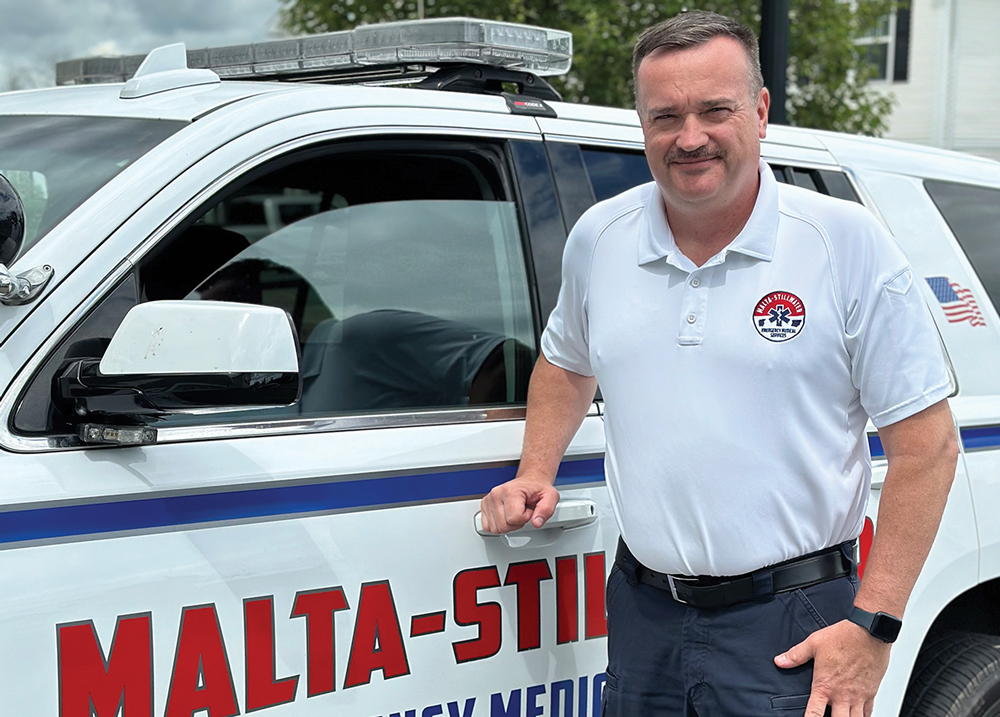
Courtesy of Malta-Stillwater EMS
By Christine Graf
For more than 30 years, Malta-Stillwater EMS Executive Director Scott Skinner has been serving the local community, racing to the scenes of fires, accidents, and other emergencies. Skinner joined the Waterville Fire Department in 1993, and it was while there that he earned his Emergency Medical Technician (EMT) certification, later working his way up to become a paramedic.
Appointed chief of the department in 2011, Skinner retired in 2014 after 21 years on the job. He joined the Round Lake Fire Department as a volunteer, and in 2018, he was hired as the executive director of the Malta-Stillwater EMS, a private, non-profit agency.
With stations in Malta and Stillwater, Malta-Stillwater EMS has 65 employees along with a dedicated crew of approximately 15 volunteers. The agency’s staff is fairly evenly split between EMTs and paramedics.
“EMTs are trained at basic life support level. They do splinting, bandaging, oxygenation, CPR, and those types of things,” said Skinner. “Paramedics receive training that is heavier on cardiology and pharmacology. They also receive advanced airway and IV training.”
Although there was a time when the agency paid for EMT and paramedic training classes, that is no longer the case.
“Years ago, they would send people to EMT and paramedic school, but a lot of those people would then end up leaving to go to some higher-paying job,” said Skinner, noting that paramedic school can cost upwards of $10,000.
For many individuals, becoming an EMT is a stepping stone, a training ground to prepare them for another career.
“The average life cycle of an EMT is just two years,” said Skinner. “In the EMS field, you tend to have older people who have been doing it forever or younger people that are looking to become firemen, cops, doctors, PAs (physician assistants)—things like that.”
According to Skinner, low wages have also contributed to the high rate of turnover among those in the EMS field.
“The pay isn’t where it should be. Our EMTs start at $20/hour, and our paramedics start at $28.75/hour.”
The Bureau of Labor Statistics lists EMTs as one of the lowest-paying jobs in health care. In 2021, approximately one-third of EMTs left the field, primarily due to low pay. Filling those job openings has become increasingly difficult for agencies throughout the country, including at Malta-Stillwater EMS.
“We were pretty well staffed before COVID, but since COVID, things have changed in the workplace,” said Skinner. “The whole medical field—not just EMS—is struggling.”
According to Skinner, his agency is also facing financial challenges. They are funded by insurance payments and patient co-pays as well as by the Town of Malta and Town of Stillwater.
“Our insurance payments are decreasing due to Medicare and Medicaid. Those payments have increased very, very little over time. When we go out the door and make $300 or $475, that doesn’t cover our out-the-door costs to go to that call,” he said.
“It’s a big problem now, and in the future it’s going to be an even bigger problem. Not enough is being done about it. We need help from the state and from the federal government. Our reimbursement rates need to go up because the cost of everything else is going up,” he added.
Individuals who refuse to pay their insurance co-pays have added another layer of complexity to the agency’s financial struggles. In order to collect, there are times that Skinner has had to go to small claims court, a nuisance that takes him away from the life-saving work that he does.
“Some people just don’t want to pay. It’s not a gigantic problem, but it’s a problem. It’s part of the equation,” he said.
Rising expenses have made the situation even more challenging, with the agency’s expenses increasing between 40 percent to 60 percent since COVID. For example, an ambulance now costs $300,000 while just six years ago, the same rig had a price tag of $174,000.
In order to meet the financial challenges, the department looks for ways to cut costs and improve efficiency.
“With our Northway corridor, we work with Clifton Park and Wilton. We share things to reduce all of our costs. We try to be very smart with what we spend our money on,” said Skinner.
Malta-Stillwater EMS has six ambulances and two fly cars (non-ambulance staff transport vehicles). At any given time, there are three ambulances on the road, two in Malta and one in Stillwater.
As an Advanced Life Support (ALS) provider, the agency’s crews are able to perform sophisticated interventions and procedures, far more than that of Basic Life Support (BLS) providers. They often save lives, stabilizing critical patients while transporting them to local hospitals.
“Our ambulances are basically emergency rooms on wheels. We always have a paramedic on board along with an EMT,” said Skinner.
In 2023, the agency responded to 3,575 incidents, saving many lives, often going above and beyond the call of duty. In February of this year, Malta-Stillwater EMS paramedic Scotty McNeff played a critical role in rescuing a man who had fallen through the ice on Round Lake. The first one on the scene, McNeff crawled out onto the lake, throwing a rope to the man, keeping him afloat until the Round Lake Fire Department’s water rescue team arrived.
“We’ve got a good company. We have good employees, and we work very hard to take care of our community,” said Skinner. “We get to help people–we get to save lives and see new lives come into the world (Skinner has delivered two babies). It’s very rewarding.”
